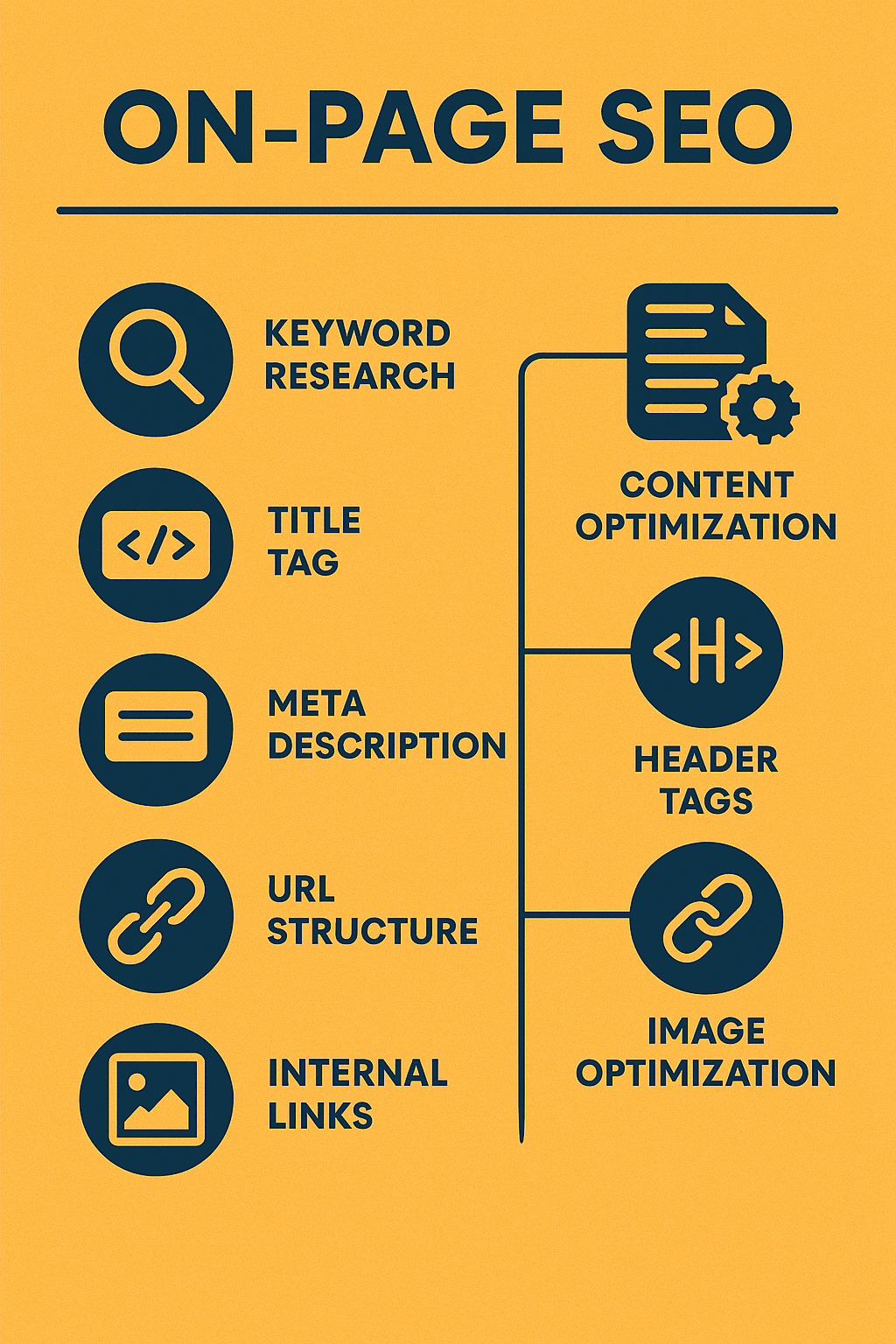How to Master Keyword Targeting and On-Page SEO
🗓️ April 01, 2025
✍️ By Shahin Neo

Hai, If you’ve ever felt confused about SEO—or even just a little intimidated—you’re not alone. I remember when I first started learning about keywords and search engine optimization. It felt like trying to solve a puzzle without knowing all the pieces. But here’s the good news: once you break it down into simple steps, it becomes much easier—and dare I say, kind of fun.
So let’s take this journey together. By the end of this post, you’ll have everything you need to start improving your website’s visibility on Google. Ready? Let’s go.
A Visual Guide to Keyword Targeting and On-Page SEO

What Are Keywords, and Why Do They Matter?
Keywords are just words or phrases people type into Google when they’re looking for something. For example, if someone searches “how to bake chocolate chip cookies,” they’re hoping to find a recipe or guide that answers their question. If you write content around those exact words, you’re more likely to show up in their search results.
Simple enough, right? But here’s where it gets interesting: choosing the right keywords can make a huge difference. Think of it like planting seeds in a garden. You want to pick the ones most likely to grow into beautiful flowers—or, in this case, clicks and traffic
How to Find the Best Keywords
AI helps search engines understand what people search for. It uses tools like machine learning and language processing. This makes search results more helpful and personal.
Let me walk you through my favorite method:
-
Start with What You Know
Ask yourself: What would you search for if you were looking for information in your field? For instance, if you run a fitness blog, you might think of terms like “easy workouts at home” or “how to stay motivated to exercise.” Trust your instincts—they’re often spot-on.
-
Use Tools to Help You Out
There are plenty of free tools out there that can help you find great keywords. One of my favorites is Google Keyword Planner . Just type in a few ideas, and it’ll suggest related terms along with how many people are searching for them each month. Easy peasy!
-
Go for Longer Phrases
Instead of targeting super broad terms like “fitness tips,” try longer phrases like “beginner workout plan for women over 40.” These are called long-tail keywords, and they’re usually easier to rank for because they’re more specific. Plus, the people searching for them tend to be closer to making a decision—which means higher-quality traffic for you.
-
Check Out Your Competition
Take a look at websites similar to yours. What keywords are they using? Tools like SEMrush or Ubersuggest can show you exactly what’s working for them. Use this as inspiration—but always add your own twist to stand out
On-Page SEO: Making Your Content Shine
Now that we’ve picked our keywords, let’s talk about how to use them effectively on your page. This part is called on-page SEO, and it’s all about helping Google understand what your content is about—and why it’s valuable.
1. Write Titles That Grab Attention
Your title is the first thing people see in search results, so make it count. Include your main keyword naturally, and keep it clear and inviting.
Example:
- Not So Great: “Workout Plans”
- Much Better: “10-Minute Morning Workout Plan to Boost Energy”
See how the second one tells you exactly what to expect—and makes you curious enough to click?
2. Craft a Meta Description That Pulls People In
The meta description is the short summary under your title in search results. It’s your chance to convince someone to visit your page. Keep it concise (about 150 characters) and include your keyword.
Example:
“Looking for a quick morning workout? Try this 10-minute routine designed to boost energy and kickstart your day!”
3. Make Your Content Easy to Read
Nobody likes reading giant blocks of text—especially online. Break up your content with headings, bullet points, and short paragraphs. Use H1 tags for your main title and H2/H3 tags for subtopics. This helps both readers and Google navigate your page easily.
4. Use Keywords Naturally
Don’t force it. Sprinkle your keywords throughout your content in places like:
- The first paragraph
- Headings and subheadings
- Image captions and alt text
- Internal links to other pages on your site
For example, if your keyword is “morning workout,” you could say something like: “Starting your day with a morning workout can give you energy and set a positive tone for the rest of your day.”
With advancements in AI in SEO, keyword research has become even more efficient. AI-powered tools can analyze trends, suggest optimal keywords, and help you understand search intent better—saving you time and improving your rankings.
5. Optimize Your Images
Images aren’t just for decoration—they play a role in SEO too. Always rename your image files descriptively and add alt text that includes your keyword.
Example:
- File Name:
morning-workout-plan.jpg - Alt Text:
A woman doing yoga poses during her morning workout
6. Make Sure Your Page Loads Fast
Have you ever clicked on a website, only to leave because it took forever to load? Yeah, me too. Slow pages frustrate users and hurt your rankings. Use tools like Google PageSpeed Insights to check your speed and fix any issues.
7. Keep Mobile Users in Mind
More than half of all web traffic comes from phones and tablets. Make sure your site looks good and works well on smaller screens. A responsive design ensures everyone has a smooth experience.
SEO Is About Connection, Not Perfection
Here’s the truth: SEO isn’t just about ranking higher—it’s about connecting with people. When you optimize your content, you’re making it easier for folks to find the answers they’re looking for. And that’s powerful.
I know it can feel overwhelming at first, but trust me—you don’t have to do everything perfectly right away. Start small. Focus on one area at a time, whether it’s tweaking your titles or adding alt text to your images. Every little improvement counts.
Remember, I’m cheering for you. If you ever feel stuck or unsure, reach out—I’d love to help. Teaching others is one of my greatest joys, and seeing people succeed fills me with pride.
Your Turn to Shine
Alright, now it’s your turn. Pick one piece of content on your site and apply what you’ve learned today. Maybe update the title, rewrite the meta description, or add some keywords. Then step back and watch what happens.
If this guide helped you, I’d love for you to pay it forward—share it with a friend or colleague who might benefit from these tips. After all, sharing knowledge is how we grow together.
You’ve got this. 💪
Until next time, happy optimizing—and thank you for letting me share this journey with you.


